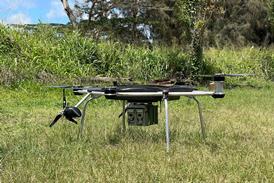Bob McKinlay began his involvement with Concorde in 1966 as the project's systems development manager at BAC. He became assistant chief engineer Concorde in 1968 and in 1971 was appointed the programme's assistant director flight test. As design director from 1976, McKinlay was central to the development of the procedures for the aircraft's operations at New York Kennedy Airport. He was later managing director of BAe Commercial Aircraft, and chairman of BAe Airbus.
Early flight testing on the prototypes showed that the intake control system was going to be a major challenge and numerous engine surges were experienced, one breaking a ramp on the French prototype 001.
The first pre-production aircraft, the BAC-built Concorde 101, was the aircraft designated for the clearance of the new digital intake control system and this aircraft was the first with digital processors in the intake control system. It was also known that testing needed to be done in the cold high-altitude conditions met near the Equator. This meant that operating from Fairford where the UK test programme was based, 101 could not spend enough time in the lower latitudes, so it was decided to use Tangier in Morocco as the base.
Tangier was ideal as it had a long runway, next to the sea, and was close enough to the lower latitudes, but it lacked the infrastructure for a complex set of flight tests. However, the locals were very helpful and we decided to go ahead on the basis that we'd set up a tented encampment with technical analysis based on the computer at Fairford.
Our stay at Tangier was full of interesting episodes but the test results were excellent, using the following routine: Concorde 101 would fly in the morning, and then our Canberra would fly the recorded tapes back to Fairford. Before dinner we would plan the outline of the next flight with the crew, and then at 21:00 we would go out to the control tower to contact Fairford by HF radio to receive the exact results from the tapes.
If necessary - and it often was - the experts would "reblow the PROMs [programmable read-only memories]" in the digital processors to change the control laws - all inside an Army tent! The next day we would repeat the process.
Although 101 returned to Tangier later (with a mobile computer) and the first production aircraft, Concorde 201, did sterling work at Casablanca, the original spell of three weeks in Tangier broke the back of the intake control system problem.
It sounds in retrospect like a rough and ready affair but, in fact, very precise flying at Mach numbers well above Mmo was accomplished by the flight crew together with the highest level of technical analysis by the specialists and maintenance by the groundcrew.
After a lengthy saga, permission to fly into New York Kennedy airport was given by the US Supreme Court in October 1977, but in 1976 and 1977 BAC and Aerospatiale spent a great deal of time refining how the aircraft would be operated to minimise the noise impact at the airport. This led to a series of meetings with Kennedy's operator, the Port Authority of New York and New Jersey, to show how the aircraft could meet the noise limits as applied to other aircraft.
We felt that the port authority understood what we were saying, but in the event it took a Court decision and it was agreed that we would do a series of evaluation flights from New York. The first was flown in October 1977 using Concorde 201 painted on one side in Air France colours and British Airways the other.
This was one of the best joint efforts ever between BAC and Aerospatiale - the French controlled the operation of the aircraft and we took the noise measurements and "managed" the media.
After arriving with no complaints being recorded, 201 was set up at a representative weight for a take-off from Kennedy's runway 31L. The aircraft took off, banking and turning left at 100ft to avoid residential areas and minimise noise. This would become the standard technique for Concorde operations at the airport.
Our measurements showed that Concorde made less noise than the 108dB necessary to trigger the port authority's noise recorder. We were more than happy at the result, but the press were very suspicious that the Port recorder was not working.
We were able to prove that it was by showing them the measurements we had taken from a DC-8, which followed Concorde's departure. It had significantly exceeded the noise limits on both our results and those from the port's recorder.
Source: Flight International
















